Northern Giant Petrel - Macronectes halli
Jan 15, 2023 4:33:51 GMT -5
Gorilla king and Montezuma like this
Post by oldcyansilverback on Jan 15, 2023 4:33:51 GMT -5
Northern Giant Petrel
Macronectes halli
Procellariforme Order - Procellaridae Family
BIOMETRICS :
Length: 80-95 cm
Wingspan: 180-210 cm
Weight: M: 5 kg – F: 3-5 kg.
DESCRIPTION:
Unlike the very similar Southern Giant-Petrel (Macronectes giganteus), the Northern Giant-Petrel does not include a real white morph, but some very pale birds can be seen, from pale brown or grey to darker coloration.
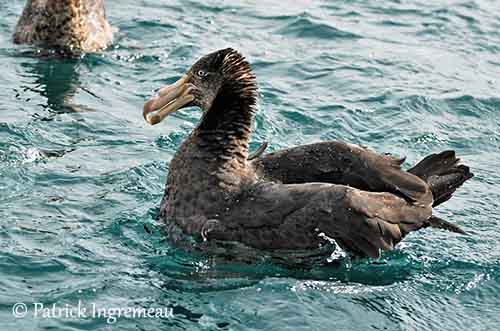
Adult male has brown plumage on the upperparts.
Underparts are paler, with pale greyish breast, belly and vent, spotted with brown. Underwings are brown and greyish, with dark brown flight feathers and trailing edge. Undertail feathers are dark brown too.
On the head, crown and nape are dark brown to blackish, extending more or less, according to each bird. Lores, cheeks and throat are whitish, slightly spotted brown.
Large, powerful bill is pale pink with darker pinkish-brown hooked tip and conspicuous tubular external nostrils on the upper mandible. (Southern Giant-Petrel has greenish tip of the bill). Eyes are pale blue. Strong legs and webbed feet are dark grey.
The female is similar in plumage, but she is slightly smaller than male.
The juvenile is blackish-brown overall, and it has dark eyes. It reaches its sexual maturity at about 6 to 7 years of age.
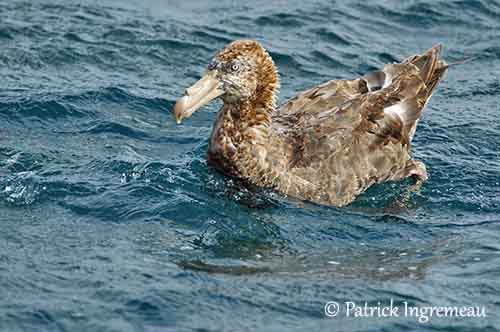
VOICE: SOUNDS BY XENO-CANTO
Northern Giant-Petrel is usually silent at sea if alone, but when they form groups around carcasses, disputes occur for food. At this moment, they utter several kinds of grunts and croaking sounds.
At nest, it gives cackling and guttural notes. We can also hear loud mewing and hisses.
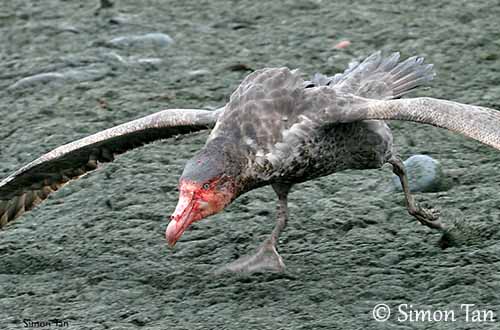
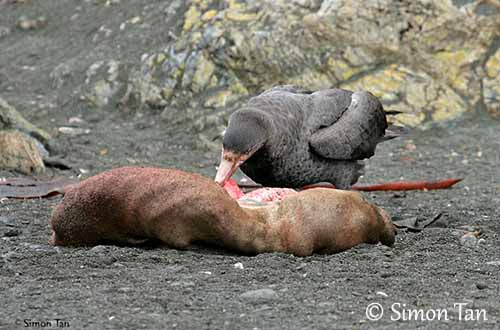
Home
Presentation
Cards
Articles
Trips
Galleries
Links
Last updates
Contact
Legal issues
Northern Giant Petrel
Macronectes halli
Procellariforme Order - Procellaridae Family
BIOMETRICS :
Length: 80-95 cm
Wingspan: 180-210 cm
Weight: M: 5 kg – F: 3-5 kg.
DESCRIPTION:
Unlike the very similar Southern Giant-Petrel (Macronectes giganteus), the Northern Giant-Petrel does not include a real white morph, but some very pale birds can be seen, from pale brown or grey to darker coloration.
Adult male has brown plumage on the upperparts.
Underparts are paler, with pale greyish breast, belly and vent, spotted with brown. Underwings are brown and greyish, with dark brown flight feathers and trailing edge. Undertail feathers are dark brown too.
On the head, crown and nape are dark brown to blackish, extending more or less, according to each bird. Lores, cheeks and throat are whitish, slightly spotted brown.
Large, powerful bill is pale pink with darker pinkish-brown hooked tip and conspicuous tubular external nostrils on the upper mandible. (Southern Giant-Petrel has greenish tip of the bill). Eyes are pale blue. Strong legs and webbed feet are dark grey.
The female is similar in plumage, but she is slightly smaller than male.
The juvenile is blackish-brown overall, and it has dark eyes. It reaches its sexual maturity at about 6 to 7 years of age.
HABITAT:
Northern Giant-Petrel is often found at sea, in coastal waters, particularly around penguins’ crèches, but it also follows trawlers far from the coasts. This species breeds on islands, in rocky slopes with scattered tussocks of vegetation.
RANGE:
Northern Giant-Petrel is circumpolar in the Southern Ocean. It breeds on islands, from South Georgia, across South Indian Ocean to New Zealand surroundings.
BEHAVIOUR:
Northern Giant-Petrel is also called the “Sea Vulture”, referring to its feeding habits. The male scavenges on seals carcasses or others and follows the ships for refuse and discarded fish. It can feed at sea or on land, where it is able to walk easily, thanks to its strong legs.
When it feeds on seals carcasses, Northern Giant-Petrel performs some dominance displays with wings outstretched and tips downwards, and head and tail raised. This large bird may kill other seabirds, even large species, by battering them to death, or by drowning them. It is very aggressive when feeding.
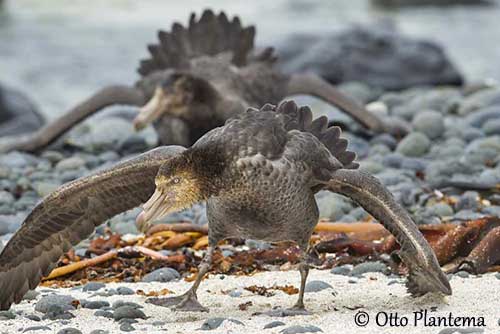
When at sea, Northern Giant-Petrel can feed on the surface, or dive down about two metres depth. It usually feeds on or near land, and very often near the coasts.
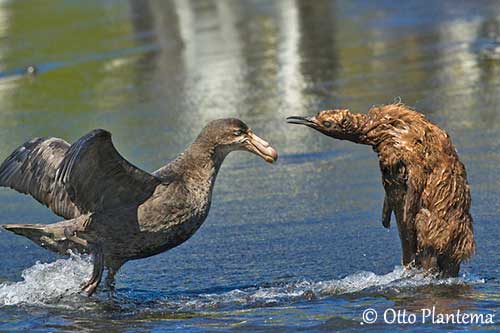
It is able to tear open the skin of dead seals, thanks to its powerful hooked bill. It often competes with other seabirds around carcasses, but its size makes it the dominant species. Females are often displaced, and they prefer to catch living preys at sea.
Usually, these birds are unable to take off after feeding at carcasses, but if they are threatened, they vomit the food in order to take flight.
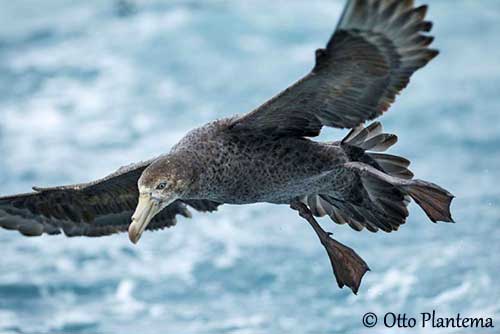
Northern Giant-Petrel defends strongly the nest-site. If disturbed or threatened, the incubating adult starts with a raucous note which ends in a kind of squawk. This is an advertising warning. But if the intruder persists, the bird ejects with precision “evil-smelling oil” at the predator. And young chicks at nest are able to perform the same behaviour.
Northern Giant-Petrel adult remains in the nearby areas of the colony after breeding period, but young birds perform dispersions over South Ocean, usually off South Africa and Australia. These birds are continually in search of food such as seals carcasses.
FLIGHT:
Northern Giant-Petrel, as other members of this family, is a good flier. It flies with alternated wing-beats and glides on stiff wings. Giant Petrels can sustain flapping flight during long period. It takes off easily, as on land or at sea.
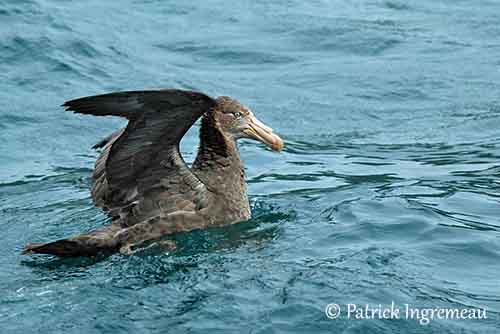
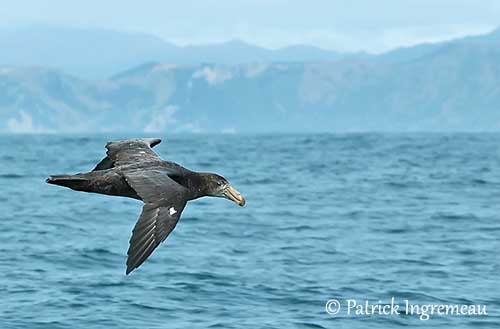
REPRODUCTION:
Breeding season usually begins in August. Northern Giant-Petrel is solitary nester, but it can breed in loose colonies, and sometimes close to Southern Giant-Petrels, among tussocks in vegetation, on rocky slopes and broken terrain areas.
The nest is situated on the ground. Northern Giant-Petrel builds a cup with twigs, grass, leaves and ferns. It is a pile of vegetation, often of 50 to 60 cm high, but it depends on material availability. The depression at the top is shallow.
The female usually lays a single white egg. Incubation lasts about 57 to 62 days, shared by both parents.
The chick is covered with grey down above, and whitish below. Both adults brood it during the first three weeks. The young fledge about 100 to 120 days after hatching.
Parents feed the chick with a regurgitated rich oily substance. The chick becomes fat and larger than adults, making it very resistant to starvation.
The young is regularly fed until fledging. At this moment, parents abandon it and the hungry young will fly out to sea one or two weeks after, for searching food on its own.
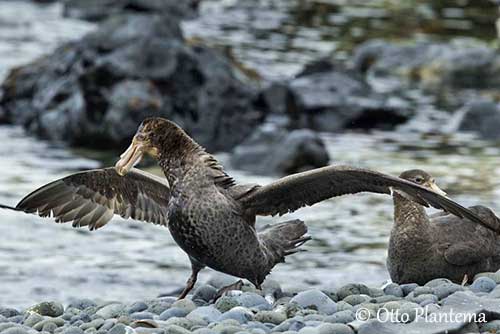
DIET:
Northern Giant-Petrel feeds mainly on seals and penguins carcasses at sea or on land, dead penguins and also discarded fish and refuse from ships.
The female feeds mainly on live preys caught at sea, such as krill and aquatic invertebrates.
PROTECTION / THREATS / STATUS:
Northern Giant-Petrels populations are not currently globally threatened, and we can see some increase, particularly at South Georgia, due to increase of seals numbers, with good availability of food resources. Population size: 11,000/14,000 mature individuals.
Predators such as introduced cats and rats, disturbances at colonies and accidents when they follow ships, play an important role in mortality of this species.
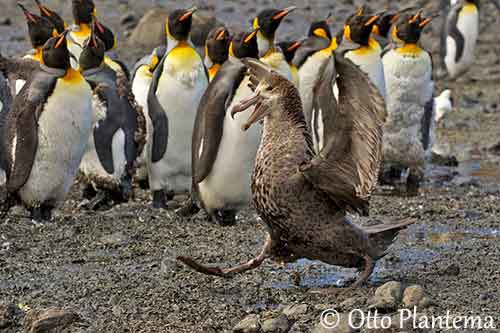
www.oiseaux-birds.com/card-northern-giant-petrel.html
Macronectes halli
Procellariforme Order - Procellaridae Family
BIOMETRICS :
Length: 80-95 cm
Wingspan: 180-210 cm
Weight: M: 5 kg – F: 3-5 kg.
DESCRIPTION:
Unlike the very similar Southern Giant-Petrel (Macronectes giganteus), the Northern Giant-Petrel does not include a real white morph, but some very pale birds can be seen, from pale brown or grey to darker coloration.
Adult male has brown plumage on the upperparts.
Underparts are paler, with pale greyish breast, belly and vent, spotted with brown. Underwings are brown and greyish, with dark brown flight feathers and trailing edge. Undertail feathers are dark brown too.
On the head, crown and nape are dark brown to blackish, extending more or less, according to each bird. Lores, cheeks and throat are whitish, slightly spotted brown.
Large, powerful bill is pale pink with darker pinkish-brown hooked tip and conspicuous tubular external nostrils on the upper mandible. (Southern Giant-Petrel has greenish tip of the bill). Eyes are pale blue. Strong legs and webbed feet are dark grey.
The female is similar in plumage, but she is slightly smaller than male.
The juvenile is blackish-brown overall, and it has dark eyes. It reaches its sexual maturity at about 6 to 7 years of age.
VOICE: SOUNDS BY XENO-CANTO
Northern Giant-Petrel is usually silent at sea if alone, but when they form groups around carcasses, disputes occur for food. At this moment, they utter several kinds of grunts and croaking sounds.
At nest, it gives cackling and guttural notes. We can also hear loud mewing and hisses.


Home
Presentation
Cards
Articles
Trips
Galleries
Links
Last updates
Contact
Legal issues
Northern Giant Petrel
Macronectes halli
Procellariforme Order - Procellaridae Family
BIOMETRICS :
Length: 80-95 cm
Wingspan: 180-210 cm
Weight: M: 5 kg – F: 3-5 kg.
DESCRIPTION:
Unlike the very similar Southern Giant-Petrel (Macronectes giganteus), the Northern Giant-Petrel does not include a real white morph, but some very pale birds can be seen, from pale brown or grey to darker coloration.
Adult male has brown plumage on the upperparts.
Underparts are paler, with pale greyish breast, belly and vent, spotted with brown. Underwings are brown and greyish, with dark brown flight feathers and trailing edge. Undertail feathers are dark brown too.
On the head, crown and nape are dark brown to blackish, extending more or less, according to each bird. Lores, cheeks and throat are whitish, slightly spotted brown.
Large, powerful bill is pale pink with darker pinkish-brown hooked tip and conspicuous tubular external nostrils on the upper mandible. (Southern Giant-Petrel has greenish tip of the bill). Eyes are pale blue. Strong legs and webbed feet are dark grey.
The female is similar in plumage, but she is slightly smaller than male.
The juvenile is blackish-brown overall, and it has dark eyes. It reaches its sexual maturity at about 6 to 7 years of age.
HABITAT:
Northern Giant-Petrel is often found at sea, in coastal waters, particularly around penguins’ crèches, but it also follows trawlers far from the coasts. This species breeds on islands, in rocky slopes with scattered tussocks of vegetation.
RANGE:
Northern Giant-Petrel is circumpolar in the Southern Ocean. It breeds on islands, from South Georgia, across South Indian Ocean to New Zealand surroundings.
BEHAVIOUR:
Northern Giant-Petrel is also called the “Sea Vulture”, referring to its feeding habits. The male scavenges on seals carcasses or others and follows the ships for refuse and discarded fish. It can feed at sea or on land, where it is able to walk easily, thanks to its strong legs.
When it feeds on seals carcasses, Northern Giant-Petrel performs some dominance displays with wings outstretched and tips downwards, and head and tail raised. This large bird may kill other seabirds, even large species, by battering them to death, or by drowning them. It is very aggressive when feeding.

When at sea, Northern Giant-Petrel can feed on the surface, or dive down about two metres depth. It usually feeds on or near land, and very often near the coasts.

It is able to tear open the skin of dead seals, thanks to its powerful hooked bill. It often competes with other seabirds around carcasses, but its size makes it the dominant species. Females are often displaced, and they prefer to catch living preys at sea.
Usually, these birds are unable to take off after feeding at carcasses, but if they are threatened, they vomit the food in order to take flight.

Northern Giant-Petrel defends strongly the nest-site. If disturbed or threatened, the incubating adult starts with a raucous note which ends in a kind of squawk. This is an advertising warning. But if the intruder persists, the bird ejects with precision “evil-smelling oil” at the predator. And young chicks at nest are able to perform the same behaviour.
Northern Giant-Petrel adult remains in the nearby areas of the colony after breeding period, but young birds perform dispersions over South Ocean, usually off South Africa and Australia. These birds are continually in search of food such as seals carcasses.
FLIGHT:
Northern Giant-Petrel, as other members of this family, is a good flier. It flies with alternated wing-beats and glides on stiff wings. Giant Petrels can sustain flapping flight during long period. It takes off easily, as on land or at sea.
REPRODUCTION:
Breeding season usually begins in August. Northern Giant-Petrel is solitary nester, but it can breed in loose colonies, and sometimes close to Southern Giant-Petrels, among tussocks in vegetation, on rocky slopes and broken terrain areas.
The nest is situated on the ground. Northern Giant-Petrel builds a cup with twigs, grass, leaves and ferns. It is a pile of vegetation, often of 50 to 60 cm high, but it depends on material availability. The depression at the top is shallow.
The female usually lays a single white egg. Incubation lasts about 57 to 62 days, shared by both parents.
The chick is covered with grey down above, and whitish below. Both adults brood it during the first three weeks. The young fledge about 100 to 120 days after hatching.
Parents feed the chick with a regurgitated rich oily substance. The chick becomes fat and larger than adults, making it very resistant to starvation.
The young is regularly fed until fledging. At this moment, parents abandon it and the hungry young will fly out to sea one or two weeks after, for searching food on its own.

DIET:
Northern Giant-Petrel feeds mainly on seals and penguins carcasses at sea or on land, dead penguins and also discarded fish and refuse from ships.
The female feeds mainly on live preys caught at sea, such as krill and aquatic invertebrates.
PROTECTION / THREATS / STATUS:
Northern Giant-Petrels populations are not currently globally threatened, and we can see some increase, particularly at South Georgia, due to increase of seals numbers, with good availability of food resources. Population size: 11,000/14,000 mature individuals.
Predators such as introduced cats and rats, disturbances at colonies and accidents when they follow ships, play an important role in mortality of this species.

www.oiseaux-birds.com/card-northern-giant-petrel.html


